HKJ
Flashaholic
Review of / Measurement on SysMax i4 V1 charger
[SIZE=+3]Charger SysMax i4 V1[/SIZE]
This review is about the V1 version of the Sysmax i4 charger. To see the difference between V1 and V2 follow this link
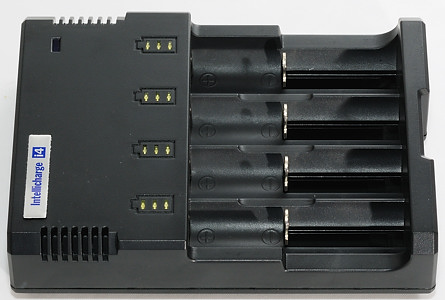
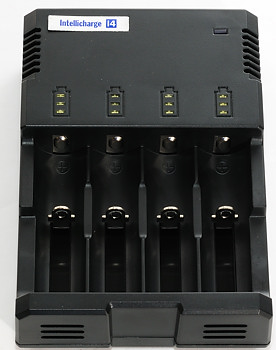
SysMax is the parent company of NiteCore and JetBeam, i.e. they are behind some good products. This charger looks impressive when reading the specifications, it can charge nearly all types of round cells and do up to four cells (nearly) independent of each other at a time. Does it really live up to this? I was very curious when starting on this review .
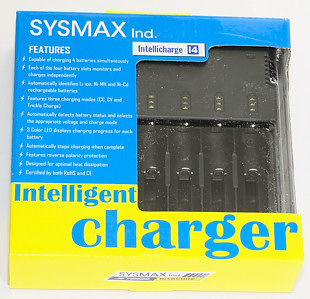
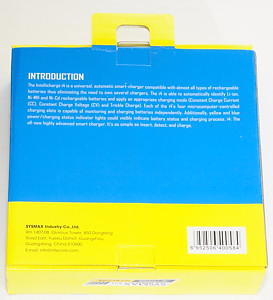
The charger comes in a cardboard box with a view to the charger and a feature list on the front. This list does not include supported cells, that are printed on the bottom of the charger.
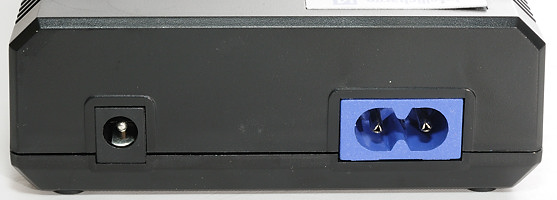
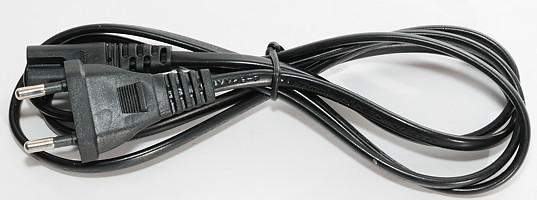
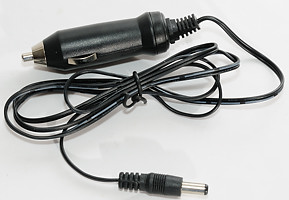
The charger is powered from either 110/220 VAC 50/60Hz or 12 VDC. Both mains and auto adapter cable was supplied with my charger.
In USA (and every other place with 110 VAC) there is reported a problem: The charger does not work correctly with 110 VAC supply. SysMax's solution to this is to ship a 110 VAC to 12 VDC adapter.
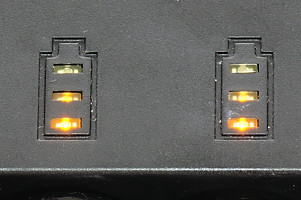
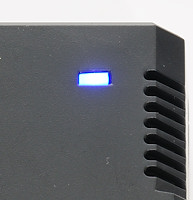
The charger has 3 yellow leds for each battery, they will show the actual charge state when charging:
None: no battery detected
1 flashing, 1 steady + 1 flashing, 2 steady + 1 flashing: Charging, number of leds is a rough guide to actual charge level.
3 steady: Battery is full.
3 flashing: Fail.
The charger also has a blue led to show "power connected".

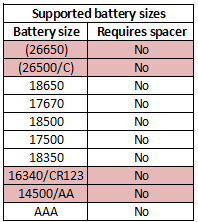
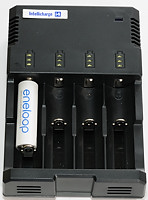
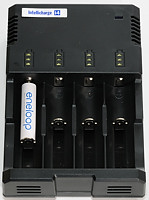
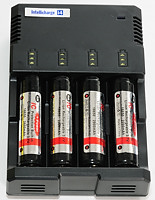
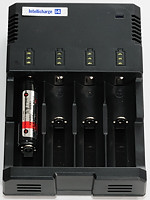
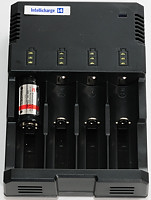
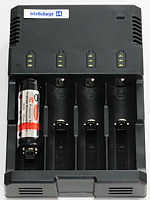
The charger can handle 69 mm long batteries, including flat top cells. (See my 18650 LiIon comparison for length of different brands).
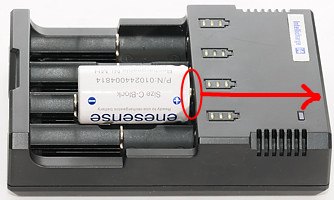
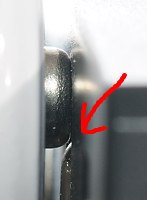
With 26650/26500/C cells there can be a problem. In the above picture I use a NiMH cell and the button top on the cells does not connect to + on the charger. This means that the charger will only work with these batteries if they have a large plus pole and also is less than 69 mm long.
With 16340 and 14500 LiIon cells the charge current is a bit high, it is not recommended to charge anything smaller.
[SIZE=+2]Measurements[/SIZE]
The charger has two charger channels, one channel is handling slot #1 and #3, the other channel is handling slot #2 and #4. When charging cells in both slots for a channel, time division is used to distribute the charge (See scope traces).
Below 0.2 volt the charger will report error (all 3 yellow leds are flashing), but a small current will flow (about 100uA), this is enough to reset a LiIon protection circuit.
Between 0.2 volt and 2 volt charger will use the NiMH charge algorithm (See curve below).
Between 2 volt and 4.2 volt the charger will use the LiIon charge algorithm (See curve below).
When NiMH charging is stopped, the charger charges with 0.1 mA.
The charge stops when the current is between 200 and 300 mA, when the charger is finishes the current goes below 20uA (This is a insignificant current).
The charger will not restart charging when the cell voltage drops.
When a battery is put into the charger, it will start charging and first stop when final charge condition is reached.
When power is connected the charger will start charging and first stop when final charge condition is reached.
When charger is disconnected from power, but with a battery in, it will draw about 220 uA from a LiIon battery.
There is some tolerance on final LiIon current and final LiIon voltage, even for the same channel.
[SIZE=+1]Test with LiIon cells[/SIZE]
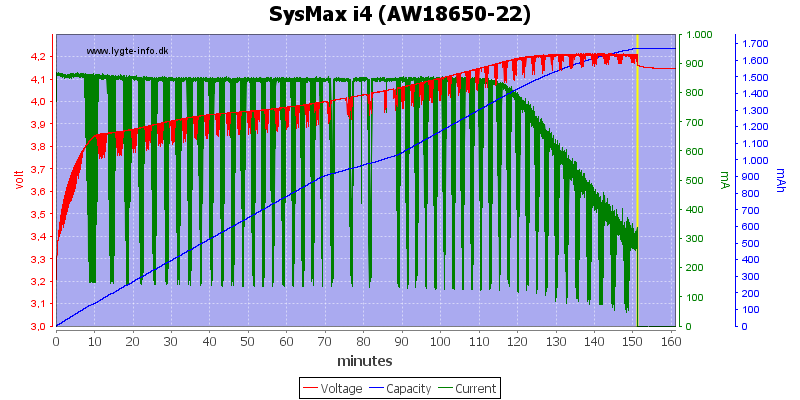
The charge curve shows a perfect CC/CV charge curve, the termination current is a bit high at 300 mA.
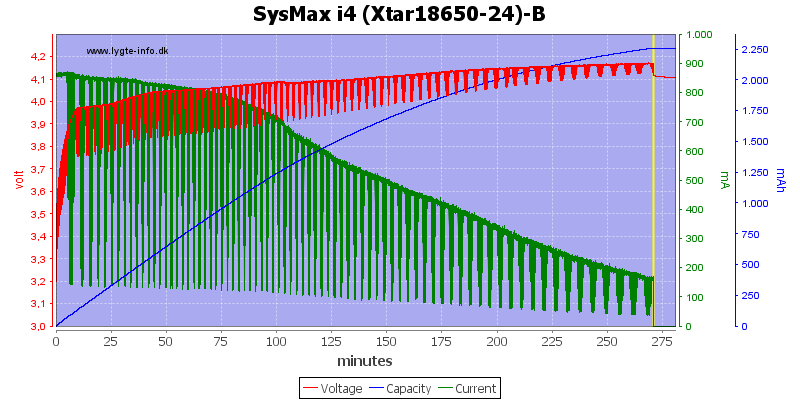
Same channel, but with another cell. This time the charger does not uses 4.2 volt as the CV value, but slowly rises to 4.17 volt and the termination current is 170 mA. The variation is not a problem for the charging, but is strange.
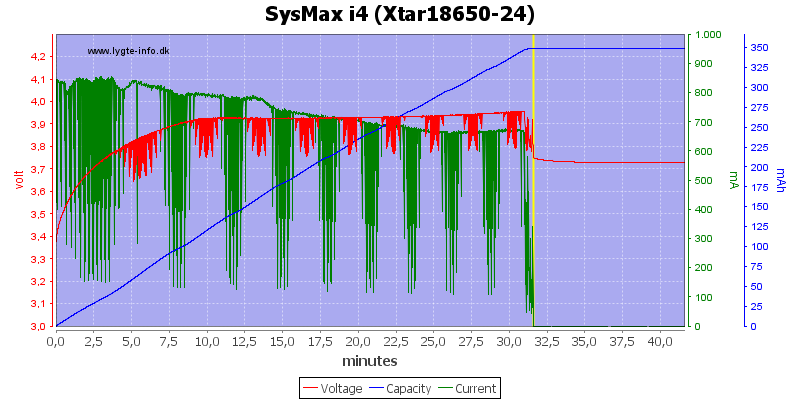
But it gets worse, again same channel. This time it uses 3.95 as the CV value and stops charging at more than 600 mA. This will not damage the battery, but it will not be charged either. I saw it a couple of times with this cell.
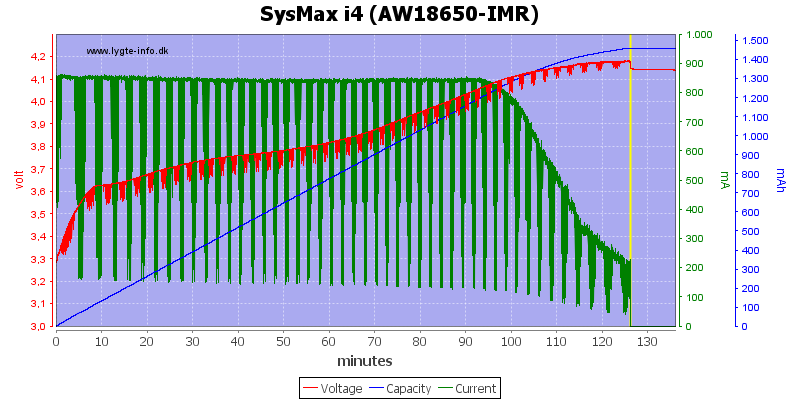
With this cell the voltage is also slightly below 4.2 volt and termination current is about 200 mA.
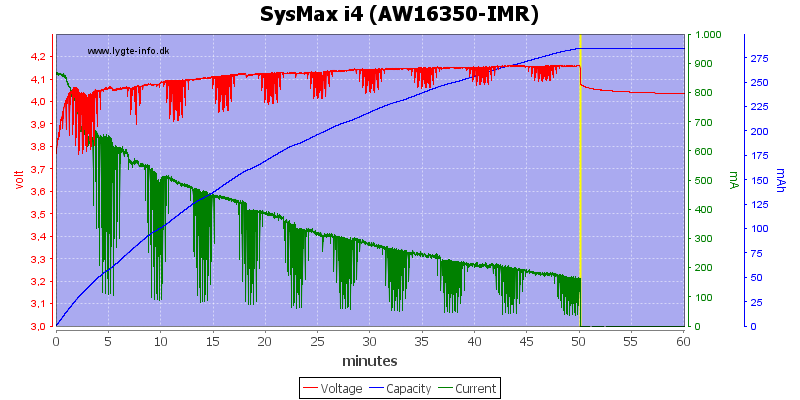
My old 16340 IMR cell. The charger charges at full current with this small cell, it starts at about 850 mA and reduces the current as voltage rises.
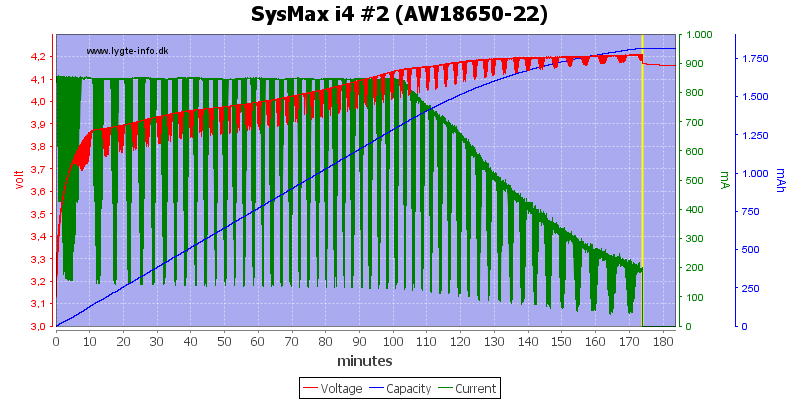
Channel #2
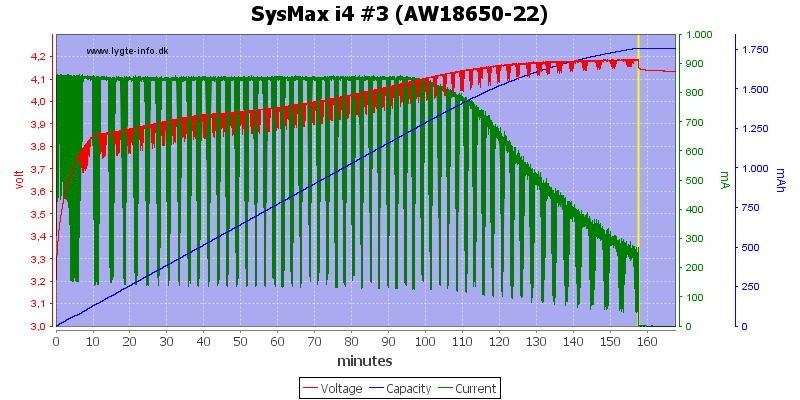
Channel #3
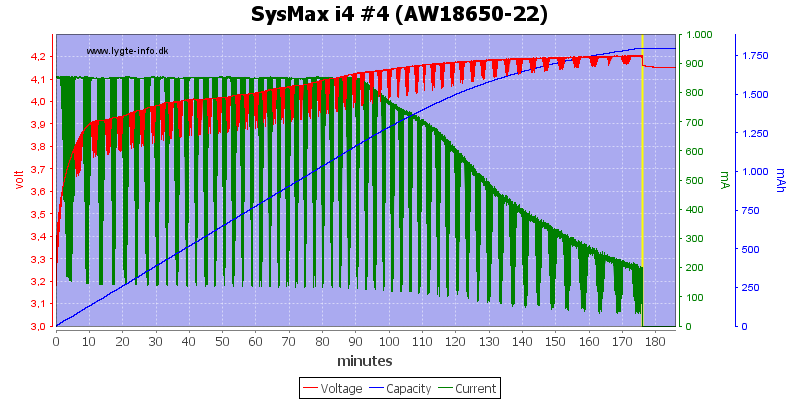
Channel #4
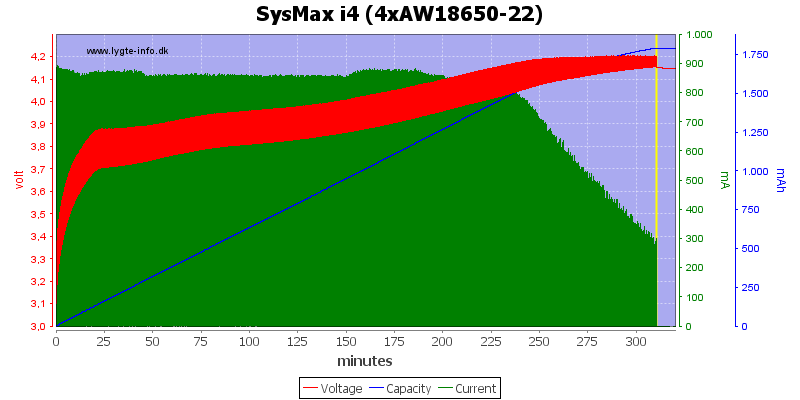
All four slots at the same time. The charge time is longer because the two channels need to share current between the four slots.
The charge current is turned off a short time when changing channel.

The full charge curve does not show how the charge current looks. For this a oscilloscope trace is needed, it shows a pulsing current. The charging circuits stops every two second to check the other slot. This timing is precise enough to make the patterns in my charge curves, that are logged each second.

With a LiIon in two slots, shared by the same charging channel, the charging is two seconds for each slot.
[SIZE=+1]Test with NiMH[/SIZE]
For testing I uses eneloop AA cells, these are a very good quality NiMH batteries with about 1950 mAh in capacity.
http://lygte-info.dk/pic/SysMax/Charger%20i4/SysMax%20i4%20(AA%20eneloop).png[img]
A NiMH AA cell does show a very nice charge curve, when the cells is full the voltage rises and then drops slightly, this stops the charger.
[IMG]http://lygte-info.dk/pic/SysMax/Charger%20i4/SysMax%20i4%20%284xAA%20eneloop%29.png
With 4 eneloop the charging stops early, but only on the slot I am measuring on. I have a suspicion that the end of charge detection circuit has problems handling two slots for a single channel.

Charging is with pulsing current (Exactly like LiIon).

With a eneloop in two slots, shared by the same charging channel, the charging is two seconds for each slot.
[SIZE=+1]Test with NiMH and LiIon and the same time[/SIZE]
According to the photos of the charger it can handle both NiMH and LiIon batteries at the same time. The specification says it can handle both types of batteries and does not include any limits on this.
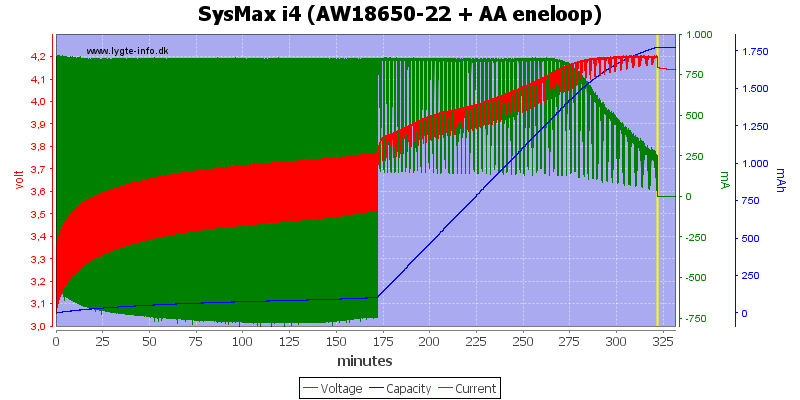
First charge curve is measured on a LiIon with a NiMH in the other slot. Look at the current scale, this looks very strange, the charger is both charging and discharging the LiIon battery for the first 175 minutes (While the eneloop is charging). During this time nearly no energy is filled into the LiIon cell. First when the eneloop is finished charging the LiIon is charged.

This curve is measured on a eneloop with a LiIon in the other slot. I had to use another scale on the current, because the charge current is considerable higher here. The charger only charges 50% of the time, but the total charge is done in only a little more time than with a NiMH cell only, due to the higher current.
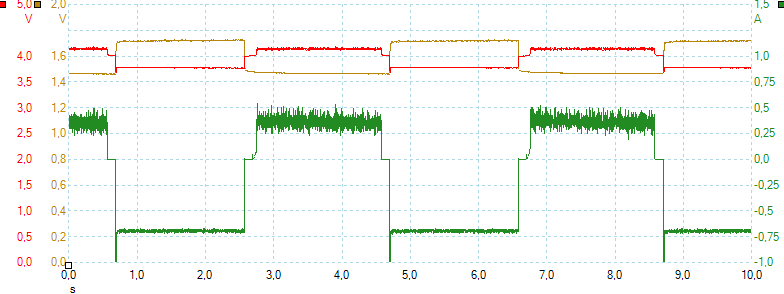
A oscilloscope trace of the charge current for the LiIon cells, shows a low charge current (350 mA) and a high discharge current (700 mA), i.e. in this case the LiIon cell is discharge to charge the NiMH cell.
With this trace I did cheat a little, I uses a nearly full LiIon cell. If I had uses a empty cell the charge current would have been larger than the discharge current. Even if the LiIon had been fully charged and charging stopped, this drain would have occured and because the charger does not restart a charging, the cell would be drained, without the status lights showing it.
The yellow trace is the voltage on the other cell, in this case the NiMH cell. This voltage is shown with too high a value (A problem with my differential probe).
With voltage traces for both cells it is also possible to see that the charger has a short pause in charging while changing between channels, this is the time where the current is zero.
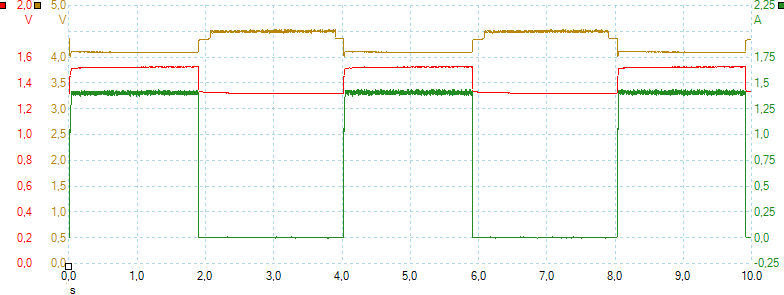
This trace shows the charge current for the NiMH cell, it is about 1.4 ampere and applied in about 50% of the time.
Again the yellow trace is the voltage on the other cell, in this case the LiIon cell. This voltage is shown with too high a value (A problem with my differential probe).
[SIZE=+2]Summary[/SIZE]
A short list of the good and the bad things with the charger. I uses ++ for the really good things and -- for the really bad things.
++ The charger uses a CC/CV algorithm (The actual charge curve varies between a perfect CC/CV and something less).
+ The charger uses a good charge current for 18650 cells.
+ The charger can be used on 12 volt.
+ Good indicator lights with estimation of charge in cells.
+ Can reset a LiIon protection circuit.
+ The slider has good connection with anything from 16340 to 18650 cells.
- The charge current is too high for small cells.
- The slots are a bit too short, 1 to 2 mm longer would have been very useful.
- Small variations in charge voltage and termination current.
- Does not really support C cells, due to connection issue.
- The NiMH charge mode prevents correct handling of over discharged LiIon.
- Can only handle one 26xxx/C cell, due to space constrains (Might be able to handle two 26xxx with a large + pole).
- NiMH charging slots does affect end of charge conditions on each other.
- The slider does not always move easily, when putting long cells in the charger.
-- LiIon charge can fail.
-- Mixing NiMH and LiIon, gives uncontrolled charge and discharge current.
-- The charger does not work on 110 VAC, except with an external power supply.
[SIZE=+2]Conclusion[/SIZE]
This charger uses a CC/CV charging profile, this is the recommended way to charge LiIon batteries, but there is more to a charger than using the correct algorithm and as my summary list shows there are a lot of small details and a few larger details that spoils it.
The charger is useable, but I would have preferred fewer issues with it. Remember when using the charge never to mix NiMH and LiIon cells in it and always use a DMM to check that LiIon are fully charged when they are removed.
[SIZE=+3]Notes[/SIZE]
Here is an explanation on how I did the above charge curves: How do I test a charger
There is a lot of noise in the charge current and I have filtered all oscilloscope traces to remove it.
[SIZE=+3]Charger SysMax i4 V1[/SIZE]
This review is about the V1 version of the Sysmax i4 charger. To see the difference between V1 and V2 follow this link


SysMax is the parent company of NiteCore and JetBeam, i.e. they are behind some good products. This charger looks impressive when reading the specifications, it can charge nearly all types of round cells and do up to four cells (nearly) independent of each other at a time. Does it really live up to this? I was very curious when starting on this review .


The charger comes in a cardboard box with a view to the charger and a feature list on the front. This list does not include supported cells, that are printed on the bottom of the charger.



The charger is powered from either 110/220 VAC 50/60Hz or 12 VDC. Both mains and auto adapter cable was supplied with my charger.
In USA (and every other place with 110 VAC) there is reported a problem: The charger does not work correctly with 110 VAC supply. SysMax's solution to this is to ship a 110 VAC to 12 VDC adapter.


The charger has 3 yellow leds for each battery, they will show the actual charge state when charging:
None: no battery detected
1 flashing, 1 steady + 1 flashing, 2 steady + 1 flashing: Charging, number of leds is a rough guide to actual charge level.
3 steady: Battery is full.
3 flashing: Fail.
The charger also has a blue led to show "power connected".








The charger can handle 69 mm long batteries, including flat top cells. (See my 18650 LiIon comparison for length of different brands).


With 26650/26500/C cells there can be a problem. In the above picture I use a NiMH cell and the button top on the cells does not connect to + on the charger. This means that the charger will only work with these batteries if they have a large plus pole and also is less than 69 mm long.
With 16340 and 14500 LiIon cells the charge current is a bit high, it is not recommended to charge anything smaller.
[SIZE=+2]Measurements[/SIZE]
The charger has two charger channels, one channel is handling slot #1 and #3, the other channel is handling slot #2 and #4. When charging cells in both slots for a channel, time division is used to distribute the charge (See scope traces).
Below 0.2 volt the charger will report error (all 3 yellow leds are flashing), but a small current will flow (about 100uA), this is enough to reset a LiIon protection circuit.
Between 0.2 volt and 2 volt charger will use the NiMH charge algorithm (See curve below).
Between 2 volt and 4.2 volt the charger will use the LiIon charge algorithm (See curve below).
When NiMH charging is stopped, the charger charges with 0.1 mA.
The charge stops when the current is between 200 and 300 mA, when the charger is finishes the current goes below 20uA (This is a insignificant current).
The charger will not restart charging when the cell voltage drops.
When a battery is put into the charger, it will start charging and first stop when final charge condition is reached.
When power is connected the charger will start charging and first stop when final charge condition is reached.
When charger is disconnected from power, but with a battery in, it will draw about 220 uA from a LiIon battery.
There is some tolerance on final LiIon current and final LiIon voltage, even for the same channel.
[SIZE=+1]Test with LiIon cells[/SIZE]

The charge curve shows a perfect CC/CV charge curve, the termination current is a bit high at 300 mA.

Same channel, but with another cell. This time the charger does not uses 4.2 volt as the CV value, but slowly rises to 4.17 volt and the termination current is 170 mA. The variation is not a problem for the charging, but is strange.

But it gets worse, again same channel. This time it uses 3.95 as the CV value and stops charging at more than 600 mA. This will not damage the battery, but it will not be charged either. I saw it a couple of times with this cell.

With this cell the voltage is also slightly below 4.2 volt and termination current is about 200 mA.

My old 16340 IMR cell. The charger charges at full current with this small cell, it starts at about 850 mA and reduces the current as voltage rises.

Channel #2

Channel #3

Channel #4

All four slots at the same time. The charge time is longer because the two channels need to share current between the four slots.
The charge current is turned off a short time when changing channel.

The full charge curve does not show how the charge current looks. For this a oscilloscope trace is needed, it shows a pulsing current. The charging circuits stops every two second to check the other slot. This timing is precise enough to make the patterns in my charge curves, that are logged each second.

With a LiIon in two slots, shared by the same charging channel, the charging is two seconds for each slot.
[SIZE=+1]Test with NiMH[/SIZE]
For testing I uses eneloop AA cells, these are a very good quality NiMH batteries with about 1950 mAh in capacity.
http://lygte-info.dk/pic/SysMax/Charger%20i4/SysMax%20i4%20(AA%20eneloop).png[img]
A NiMH AA cell does show a very nice charge curve, when the cells is full the voltage rises and then drops slightly, this stops the charger.
[IMG]http://lygte-info.dk/pic/SysMax/Charger%20i4/SysMax%20i4%20%284xAA%20eneloop%29.png
With 4 eneloop the charging stops early, but only on the slot I am measuring on. I have a suspicion that the end of charge detection circuit has problems handling two slots for a single channel.

Charging is with pulsing current (Exactly like LiIon).

With a eneloop in two slots, shared by the same charging channel, the charging is two seconds for each slot.
[SIZE=+1]Test with NiMH and LiIon and the same time[/SIZE]
According to the photos of the charger it can handle both NiMH and LiIon batteries at the same time. The specification says it can handle both types of batteries and does not include any limits on this.

First charge curve is measured on a LiIon with a NiMH in the other slot. Look at the current scale, this looks very strange, the charger is both charging and discharging the LiIon battery for the first 175 minutes (While the eneloop is charging). During this time nearly no energy is filled into the LiIon cell. First when the eneloop is finished charging the LiIon is charged.

This curve is measured on a eneloop with a LiIon in the other slot. I had to use another scale on the current, because the charge current is considerable higher here. The charger only charges 50% of the time, but the total charge is done in only a little more time than with a NiMH cell only, due to the higher current.

A oscilloscope trace of the charge current for the LiIon cells, shows a low charge current (350 mA) and a high discharge current (700 mA), i.e. in this case the LiIon cell is discharge to charge the NiMH cell.
With this trace I did cheat a little, I uses a nearly full LiIon cell. If I had uses a empty cell the charge current would have been larger than the discharge current. Even if the LiIon had been fully charged and charging stopped, this drain would have occured and because the charger does not restart a charging, the cell would be drained, without the status lights showing it.
The yellow trace is the voltage on the other cell, in this case the NiMH cell. This voltage is shown with too high a value (A problem with my differential probe).
With voltage traces for both cells it is also possible to see that the charger has a short pause in charging while changing between channels, this is the time where the current is zero.

This trace shows the charge current for the NiMH cell, it is about 1.4 ampere and applied in about 50% of the time.
Again the yellow trace is the voltage on the other cell, in this case the LiIon cell. This voltage is shown with too high a value (A problem with my differential probe).
[SIZE=+2]Summary[/SIZE]
A short list of the good and the bad things with the charger. I uses ++ for the really good things and -- for the really bad things.
++ The charger uses a CC/CV algorithm (The actual charge curve varies between a perfect CC/CV and something less).
+ The charger uses a good charge current for 18650 cells.
+ The charger can be used on 12 volt.
+ Good indicator lights with estimation of charge in cells.
+ Can reset a LiIon protection circuit.
+ The slider has good connection with anything from 16340 to 18650 cells.
- The charge current is too high for small cells.
- The slots are a bit too short, 1 to 2 mm longer would have been very useful.
- Small variations in charge voltage and termination current.
- Does not really support C cells, due to connection issue.
- The NiMH charge mode prevents correct handling of over discharged LiIon.
- Can only handle one 26xxx/C cell, due to space constrains (Might be able to handle two 26xxx with a large + pole).
- NiMH charging slots does affect end of charge conditions on each other.
- The slider does not always move easily, when putting long cells in the charger.
-- LiIon charge can fail.
-- Mixing NiMH and LiIon, gives uncontrolled charge and discharge current.
-- The charger does not work on 110 VAC, except with an external power supply.
[SIZE=+2]Conclusion[/SIZE]
This charger uses a CC/CV charging profile, this is the recommended way to charge LiIon batteries, but there is more to a charger than using the correct algorithm and as my summary list shows there are a lot of small details and a few larger details that spoils it.
The charger is useable, but I would have preferred fewer issues with it. Remember when using the charge never to mix NiMH and LiIon cells in it and always use a DMM to check that LiIon are fully charged when they are removed.
[SIZE=+3]Notes[/SIZE]
Here is an explanation on how I did the above charge curves: How do I test a charger
There is a lot of noise in the charge current and I have filtered all oscilloscope traces to remove it.
Last edited:

